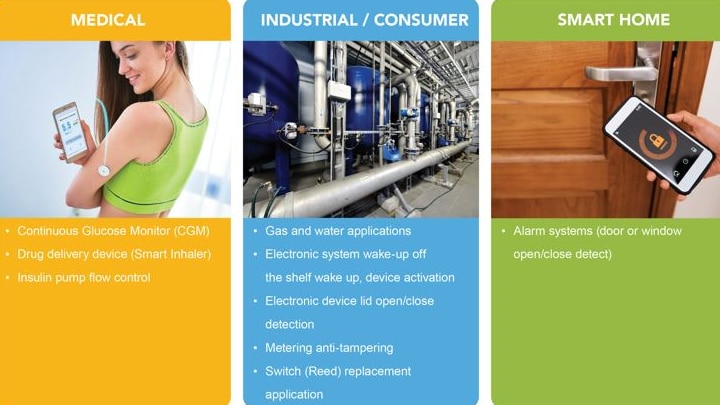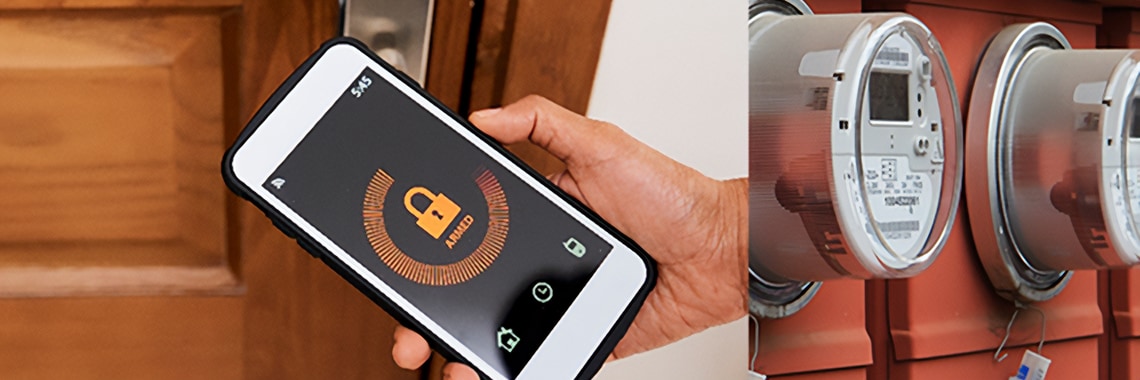Sensors collect critical data from the environment which can be turned
into useful insights in almost every industry. But they have varying
capabilities, reliability and levels of innovation which ultimately
determine the experiences they can deliver. Our recently launched NMH1000 Magnetic Switch
is designed to meet today’s market needs. It is a rare breed of magnetic
sensor that replaces traditional bulky mechanical switches which are
unsuitable for difficult environmental conditions. The three reasons to consider NHM1000 for your development include its distinctive features, flexible application and ability to easily onboard.
Distinctive Features of the NMH1000
The NMH1000 is most sensitive to the magnetic fields that vertically pass
through the top-to-bottom surfaces. Input consists of a magnetic field
ranging in strength from earth-bound background, up to maximum BGMAX. Its
input processing consists of functional blocks such as a configurable state
machine, analog-to-voltage conversion of the input and comparison to
generate the output, arranged in linear succession.
The sensor detects the absence of a magnetic field and outputs either a high
or low state upon comparison with preset thresholds. It operates down to
1.2V supply voltage, which ensures longer shelf life with ultra-low power
consumption (75 nA typ. @ 1 Hz sample rate). And it comprises a small DFN
package, making it easy to integrate in very small areas. The NMH1000 also
supports two operation modes: the standalone mode and the I2C user mode. In the standalone mode, the sensor’s interface to its host is
extremely simple, while the I2C provides a more sophisticated interface to
extract additional functions.
Use Cases for the NMH1000
A key differentiator of the NMH1000 sensor is its flexibility. It can be
used for medical, industrial, consumer and smart home applications. These
include CGMs, continuous glucose monitoring, drug delivery devices such as
a Smart Inhaler, electronic wake-up systems, gas and water flow
applications, anti-tampering metering, reed switch replacement and alarm
systems. The sensor can add new experiences to some of these applications.
For example, the NHM1000 is handy in situations where smoke detectors are
out of reach with no easy way to test their functionality. In this case,
the sensor can be used with a telescoping magnet for testing from ground
level. This can be done by positioning the magnet near the smoke detector
to put it into test mode.
Another interesting use case of the NMH1000 is laptop power control. In
this use case, a magnet is on the laptop monitor and the NMH1000 is on the
keyboard. When the lid comes down, the magnet is close to the NMH1000, so
its output will change state. This notifies the controller to switch off
the display and disable the keyboard. And when the lid is opened, the
magnet disappears and the NHM1000 will change the state to the other
direction, telling the system to turn on the display and the keyboard.
 A list of some applications for NXP NMH1000 Magnetic Switch
A list of some applications for NXP NMH1000 Magnetic Switch
Onboard Easily with NMH1000 Freedom Shield Evaluation Board
We developed the NMH1000 Freedom Shield Evaluation Board
to help our customers evaluate the NMH1000 and kickstart their development
speedily. The board can be connected easily to an NXP Freedom MCU board via
the Arduino headers for evaluation. It has all the necessary headers,
jumpers and signal test points to quickly evaluate the NMH1000 magnetic
sensor.
Users can connect the two boards to evaluate the NMH1000 magnetic sensor.
This is possible with either a terminal program using the NXP Component
Library or a standalone mode use case. These evaluation boards provide an
intuitive way to change between the sensor’s standalone modes and the I²C
interface for communication through jumper selections. At the same time,
they provide test points that are typically used for evaluation.
Learn more about our NMH1000 magnetic switch
and discover how it can help meet your needs.




